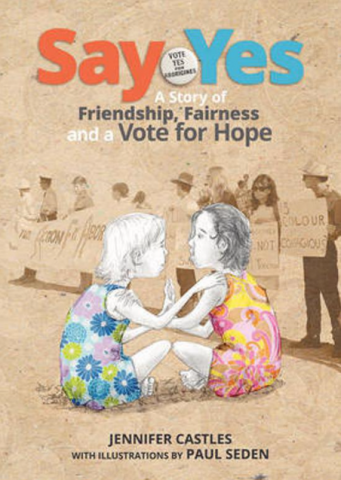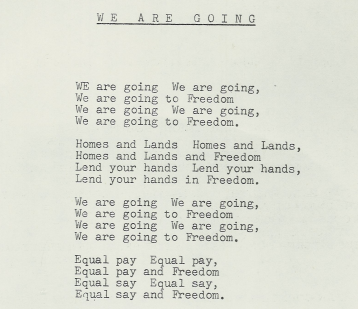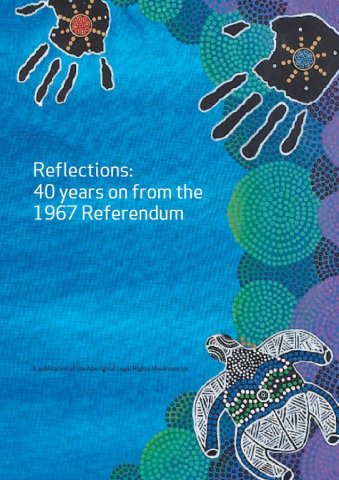
Jennifer Castles & Paul Seden, Say yes : a story of friendship, fairness and a vote for hope (Crows Nest, NSW: Allen & Unwin, 2017)
FURTHER READING

Jennifer Castles & Paul Seden, Say yes : a story of friendship, fairness and a vote for hope (Crows Nest, NSW: Allen & Unwin, 2017)
FEATURED RESOURCE

Gary Shearston, extract of the poem We Are Going (to freedom) adapted from We are Going by Oodgeroo Noonuccal for the 1967 Referendum from the Papers of Charles Perkins, 1956-1993
FURTHER READING

Marilyn Lake, Faith : Faith Bandler, gentle activist (Crows Nest, N.S.W: Allen & Unwin, 2002)
The 1967 Referendum was a symbolic, watershed moment in the Aboriginal and Torres Strait Islander rights movement. The campaign had shone a light on the living conditions and the discrimination faced by Indigenous Australians. There was little immediate change as policy relating to Indigenous Australians were still primarily administered by the states. It was not until the Whitlam Government (1972-1975) that the Commonwealth took an active role in Indigenous affairs through a policiy of self-determinism.
Not everyone believed that the 1967 Referendum had any impact on the lives of Indigenous Australian:
“Looking back, the only major improvement has been the 93% ‘Yes’ vote of the referendum of May 1967; but this improvement did not benefit the black Australians though it eased the guilty conscience of White Australians in this country and overseas."
- Kath Walker, ‘Black-White Coalition Can Work’, Origin 1(4), 1969, p.6.
Despite the success of the YES campaign, there remain significant divides. Indigenous Australians have a lower life expectancy than non-Indigenous people (12.5% less for men, 10% for women) and on average a higher unemployment rate at 16% for Indigenous Australians compared to 5% for non-Indigenous people. You can read more detailed statistics on the Australian Bureau of Statistics website
The Closing the Gap campaign is an initiative of the Department of Prime Minister and Cabinet which aims to ultimately eliminate disparity between Indigenous and non-Indigenous Australians across health, mortality rates, living conditions, employment, education, income, and rates of incarceration. The initiatives of the Closing the Gap campaign can be seen as a direct result of the successful referendum, which allowed the Commonwealth the power to make laws for Aboriginal and Torres Strait Islander people.
Twenty-five years after the 1967 Referendum, Native Title recognised the ownership and connection of Indigenous Australians to their traditional lands. In 1982 Edward Koiki Mabo (1936-1992) of Mer (Murray) Island in the Torres Strait, James Rice and David Passi commenced proceedings in the High Court against Queensland and the Commonwealth. They sought a declaration that the annexation of Murray Island by Queensland in 1879 had not extinguished native title in respect of its lands and waters. In 1988 the High Court ruled in Mabo (No. 1) that the Act was invalid, as it was inconsistent with the 1975 Racial Discrimination Act. In 1992, by a majority of 6:1, the High Court of Australia held that the Meriam people were entitled to the full ownership, occupation and use of Murray Island.
The 50th anniversary of the 1967 Referendum, has seen a movement towards Constitutional Recognition of Aboriginal and Torres Strait Islander people and to remove sections of the Constitution which empower the Government to make laws for any group of people based on their race. You can read more about the campaign for Constitutional recognition on the Australian Human Rights Commission website, on the website of the National Indigenous Australians Agency, or on the website of lobby group Recognise.
Malcolm Mackay interviewed by Bernadette Schedvin for Parliament's oral history project
In this interview, Dr. Malcolm Mackay talks about the 1967 Referendum impact on Indigenous Australians.
Chains or change [picture] : National Aborigines Day 8th July 1977 / issued by the National Aborigines' Day Observance Committee [Sydney : National Aborigines' Day Observance Committee, 1977]
A red, black, yellow and white poster designed to appear like the Aboriginal Australian flag. The yellow circle at the centre of the poster features the face of an Indigenous man wearing a chain around his neck, and is enclosed by a large white question mark. At footer of poster: "1967: Referendum. 1977: where is justice - land - compensation - dignity? Queensland discriminatory acts still exist. U.N year to end discrimination."
Advance Australia where? : National Aborigines' Day Friday, July 14, 1972 [Sydney : National Aborigines' Day Observance Committee (NAIDOC), 1972]
Poster celebrating first National Aborigines' Day observed on the 14th of July 1972, after the Department of Aboriginal Affairs was formed as a major outcome of the 1967 Referendum.

National Aborigines' Day Observance Committee, Chains or change: National Aborigines Day 8th July 1977, nla.cat-vn6186422
FURTHER READING

Neil Gillespie (ed), Reflections: 40 years on from the 1967 referendum (Adelaide, S. Aust: Aboriginal Legal Rights Movement Inc., 2007)
MANUSCRIPTS

Most of our manuscript material are held in boxes such as this one. There are over 11,500 individual collections held in the Library, waiting to be discovered.